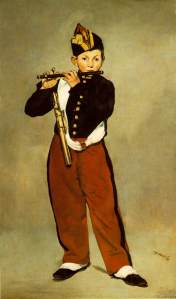Edouard Manet, The Fifer (1866). Oil on canvas, 160 x 97 cm. Musee d’Orsay, Paris.
Who it was that began the new realism in art
Clarity, candour, culture, courtesy and a virtuous ability to handle paint are said to be the most striking qualities of Edouard Manet!
Manet’s painting of 1866 – The Fifer – depicts a teenage musician from a ceremonial military band, who is standing all alone. This young artiste, appears at first glance to be very direct and uncomplicated, thus the stripe of the trouser in particular (according to John Richardson, 1982) boldly outlines the body, and separates it.
Oddly enough, the figure itself is surrounded by nothing but air. In addition, this small boy’s striking pose is likely to have been derived from a picture on a French tarot card and he does look a little deceptive / intriguing; is there perhaps more to this painting than a charming young man in uniform?
French model Victorine Meurent was a favorite of Manet and appeared in many of his pictures, thus Victorine is clearly seen in the effeminate face of this young fifer, as can Leon Leenhoff who was Manet’s stepson.
Young and handsome, the lad is positioned on the canvas in shallow depth without much geometrical framework; hence, this large, single figure has emphatic contours with sharp blacks and reds, beating out at the viewer.
A ‘fife’ is a high pitched musical instrument (a little like a flute) originating from medieval Europe; popular in marching bands, fifes have appeared regularly as symbols within paintings throughout European art history.
Furthermore, this picture is sometimes referred to as “Young Flautist” hence, Manet completed it after a trip to Spain and it reflects the influence of Pablo de Valladolid, who was an artist Manet would have studied at the Museo del Prado, upon his sojourn to Madrid.
Upon his return to Paris, Edouard Manet decided to portray an anonymous boy in a picture like he was part of the Imperial Guard’s military band, and the artist brought many Spanish ideas home with him to provide a truly modern feeling in France.
Lifelike and alive The Fifer himself, really stands out against an extremely dull, monochrome background; as such, there is a flat emptiness of clear space that gives a strange silence to a musical painting!
It wasn’t until 1884 however (after the artist’s death) that this painting was exhibited in a retrospective exhibition of Manet’s work, having been organized as a tribute to the man who has become known as the Father of Impressionism – even this harmless little boy was yet another rejection by those notorious judges at the Salon de Paris!
Both a devoted and domesticated family man, Edouard Manet was also a pious Catholic and skeptical humanist; now truly loved by the artworld, it has been suggested that he was the first modern painter, and the last classical artist.
.
Beautifully illustrated in colour – Raphael: From Urbino to Rome – tells the story of one of Italy’s most revered Renaissance artists.
Raffaello’s artistic journey from his birthplace in Urbino via the Florentine inspiration of Leonardo and Michelangelo to the papal court of Rome, is quite possibly the most fascinating biographical monograph of recent times.
Raffaello di Giovanni Santi began his career decorating provincial churches and finished it one of the greatest Italian masters.
Chapman’s monograph (with the help of Tom Henry and Carol Piazzotta) explores the influence of Raphael’s father, Giovanni Santi, and their early work in Umbria.
Drawing on documentary evidence, these authors have most importantly investigated Raffaello’s flourishing artwork in Rome under the patronage of Pope Julius II; this beautifully illustrated art exhibition catalogue has over 90 of Raphael’s paintings and drawings with informative scholarly interpretation.
Chapman does a marvellous job of covering not just the artwork of Raphael (presented immaculately), but his entire journey to Rome in the Quattrocento Italian Renaissance.
Renaissance biographer Giorgio Vasari said: “Heaven sometimes shows itself in showering upon one single person the infinite riches of its treasures, and all those graces and rarest gifts could be clearly seen in the no less excellent than gracious Raffaello Sanzio da Urbino.”
Raphael’s most amazing work of art is The School of Athens, wonderfully presented in this publication; the painting depicts a great many ancient Greek philosophers. Now hanging in the Vatican it is oil on canvas with Plato and his student Aristotle in the centre, while Socratesis quite unmistakable. Has Raphael not completely harnessed the perfect embodiment of High Renaissance with this masterpiece?
Published to accompany the Raphael Exhibition at the National Gallery in 2004/5 – Raphael: From Urbino to Rome – was Book of the Year and Winner of the Exhibition Catalogue category at the British Book Design and Production Awards of 2005.
Author Hugo Chapman has an art history degree from London University and has written widely on Italian Renaissance art; Tom Henry is a senior lecturer in art history and has worked at the National Gallery and Carol Piazzotta has also had success with her book on Guercino from 1991.
Available now, this well-written biography about Raphael’s journey has 320 pages, many of which are colour illustrations in a large and accessible size.
Chapman, Henry and Piazzotta. 2008 – Raphael: From Urbino to Rome – National Gallery Company.
